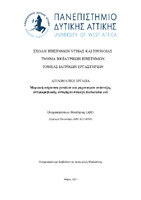| dc.contributor.advisor | Beloukas, Apostolos | |
| dc.contributor.author | Πολονύφη, Δήμητρα | |
| dc.date.accessioned | 2021-10-21T11:27:45Z | |
| dc.date.available | 2021-10-21T11:27:45Z | |
| dc.date.issued | 2021-10-04 | |
| dc.identifier.uri | https://polynoe.lib.uniwa.gr/xmlui/handle/11400/1398 | |
| dc.identifier.uri | http://dx.doi.org/10.26265/polynoe-1249 | |
| dc.description.abstract | Η ανακάλυψη και η εφαρμογή των αντιβιοτικών για την πρόληψη και τη θεραπεία των
ασθενειών, τόσο στην ιατρική όσο και την κτηνιατρική αποτέλεσε σταθμό στην ιατρική
επιστήμη. Όμως η ευρεία και πολλές φορές αλόγιστη χρήση τους, έχει οδηγήσει σε
ανησυχητική αύξηση των ανθεκτικών βακτηριακών στελεχών, δυσκολεύοντας έτσι την
θεραπεία των λοιμώξεων. Το φαινόμενο της μικροβιακής αντοχής αποτελεί πλέον ένα από τα
σοβαρότερα προβλήματα δημόσιας υγείας του 21ου αιώνα. Τα ανθεκτικά βακτήρια δεν
εντοπίζονται μόνο στο περιβάλλον του νοσοκομείου. Βάσει της διεθνούς βιβλιογραφίας
ανθεκτικοί μικροοργανισμοί εντοπίζονται συνεχώς στο υδάτινο περιβάλλον (όπως ποτάμια,
λίμνες), στα λύματα και στο έδαφος. Σε αυτά τα ενδιαιτήματα ευνοείται η οριζόντια μεταφορά
γονιδίων αντοχής, συμβάλλοντας στην περαιτέρω εξάπλωση των ανθεκτικών πληθυσμών.
Επιπλέον, τα επιβαρυμένα ποτάμια (αποδέκτες λυμάτων) αποτελούν πηγή μόλυνσης από
ανθεκτικά και πολύ-ανθεκτικά βακτήρια καθώς συχνά αξιοποιούνται για αρδευτικούς και
ψυχαγωγικούς (ψάρεμα, κωπηλασία, κολύμπι) σκοπούς. Το βακτήριο Escherichia coli (E. coli)
καθώς συγκαταλέγεται στους φυσιολογικούς άποικους του γαστρεντερικού σωλήνα των
ανθρώπων και των άλλων θερμόαιμων ζώων, καταλήγει στο λύμα και μέσω αυτού στο υδάτινο
οικοσύστημα. Αποτελεί βασικό και καθιερωμένο δείκτη πρόσφατης κοπρανώδους μόλυνσης
των υδάτων. Επιπρόσθετα, είναι η πιο κοινή αιτία ουρολοιμώξεων και γαστρεντερίτιδων, τόσο
στο νοσοκομειακό περιβάλλον όσο και στη κοινότητα. Επομένως η εμφάνιση ανθεκτικών και
πολύ-ανθεκτικών στελεχών E. coli έχει προκαλέσει τεράστια ανησυχία στην επιστημονική
κοινότητα. Για αυτό το λόγο, σκοπός της παρούσας διπλωματικής εργασίας ήταν η μοριακή
ανίχνευση γονιδίων αντιμικροβιακής αντοχής σε στελέχη E. coli, τα οποία απομονώθηκαν τον
Ιούλιο του 2020 από το Ποτάμι Έρκυνα της Λιβαδειάς, στο οποίο εκβάλει το λύμα της
Μονάδας Επεξεργασίας Λυμάτων της περιοχής. Συνολικά απομονώθηκαν τριάντα ένα (31)
στελέχη E. coli, τα οποία υποβλήθηκαν: α) σε έλεγχο μικροβιακής ευαισθησίας σε 18 ευρέως
χρησιμοποιούμενα αντιβιοτικά, β) σε φυλογενετική ταξινόμηση με τη μοριακή μέθοδο του
Phylogrouping και γ) σε έλεγχο παρουσίας γονιδίων αντοχής με την μέθοδο της PCR. Βάσει
των αποτελεσμάτων η πλειοψηφία των στελεχών (23/31 ή 74,2%) εμφάνισε αντοχή σε
τουλάχιστον ένα αντιβιοτικό παράγοντα ενώ σε 4 στελέχη ανιχνεύθηκαν γονίδια που
προσδίδουν αντοχή σε καφαλοσπορίνες εκτεταμένου φάσματος. Σύμφωνα με τη φυλογενετική
τυποποιητική μέθοδο, κατατάχθηκαν σε 4 ομάδες με την ομάδα A να είναι επικρατέστερη
(20/31 ή 64,50%). | el |
| dc.format.extent | 40 | el |
| dc.language.iso | el | el |
| dc.publisher | Πανεπιστήμιο Δυτικής Αττικής | el |
| dc.rights | Αναφορά Δημιουργού - Μη Εμπορική Χρήση - Παρόμοια Διανομή 4.0 Διεθνές | * |
| dc.rights | Attribution-NonCommercial-NoDerivatives 4.0 Διεθνές | * |
| dc.rights.uri | http://creativecommons.org/licenses/by-nc-nd/4.0/ | * |
| dc.subject | Escherichia coli | el |
| dc.subject | Αντιβιοτικά | el |
| dc.subject | Ενιαία υγεία | el |
| dc.subject | Μικροβιακή αντοχή | el |
| dc.subject | Γονίδια αντοχής | el |
| dc.title | Μοριακή ανίχνευση γονιδίων και μηχανισμών ανάπτυξης αντιμικροβιακής αντοχής σε στελέχη Escherichia coli. | el |
| dc.title.alternative | Molecular detection of genes and mechanisms for the development of antimicrobial resistance in Escherichia coli strains. | el |
| dc.type | Πτυχιακή εργασία | el |
| dc.contributor.committee | Beloukas, Apostolos | |
| dc.contributor.committee | Βογιατζάκη, Χρυσάνθη | |
| dc.contributor.committee | Παππά, Όλγα | |
| dc.contributor.faculty | Σχολή Επιστημών Υγείας & Πρόνοιας | el |
| dc.contributor.department | Τμήμα Βιοϊατρικών Επιστημών | el |
| dc.description.abstracttranslated | The discovery and application of antibiotics for the prevention and treatment of diseases, both
in medicine and veterinary medicine was a milestone in medical science. However, their
widespread and often reckless use has led to a worrying increase in resistant bacterial strains,
making it difficult to treat infections. The phenomenon of antimicrobial resistance is a major
public health issue. Resistant bacteria are not only found in the hospital environment.
According to the international literature, resistant microorganisms are constantly found in the
aquatic environment (such as rivers, lakes), sewage and soil. Horizontal transfer of resistance
genes is favored in these habitats, contributing to the further spread of resistant populations. In
addition, polluted rivers (sewage recipients) are a source of contamination by resistant and
highly resistant bacteria as they are often used for irrigation and recreational purposes (fishing,
rowing, swimming). The bacterium Escherichia coli (E. coli) as one of the normal colonists of
the gastrointestinal tract of humans and other warm-blooded animals, ends up in the sewage
and through it in the aquatic ecosystem. It is a basic and well-established indicator of recent
faecal water contamination. In addition, it is the most common cause of urinary tract infections
and gastroenteritis, both in the hospital setting and in the community. Therefore, the emergence
of resistant and multi-resistant E. coli strains has caused great concern in the scientific
community. For this reason, the purpose of this dissertation was the molecular detection of
antimicrobial resistance genes in E. coli strains, which were isolated from the Erkyna River of
Livadia. This river is directly influenced by the regional wastewater treatments plant (WWTP)
discharges. We isolated thirty-one (31) E. coli strains which were examined for: a)
antimicrobial susceptibility/resistance level in 18 antibiotics and b) presence of resistance
genes. Also were classified into four phylogenetic groups according to Phylogrouping-triplex
pcr method. Based on the results, the majority of strains (23/31 or 74.2%) showed resistance to
at least one antibiotic agent, while in 4 isolates were identified antimicrobial genes which confer
resistance to broad-spectrum cephalosporins. According to the results of Phylogrouping
method, they were classified into 4 groups (A, B1, B2, D) with A being the predominant group
(20/31 or 64.50%) | el |



